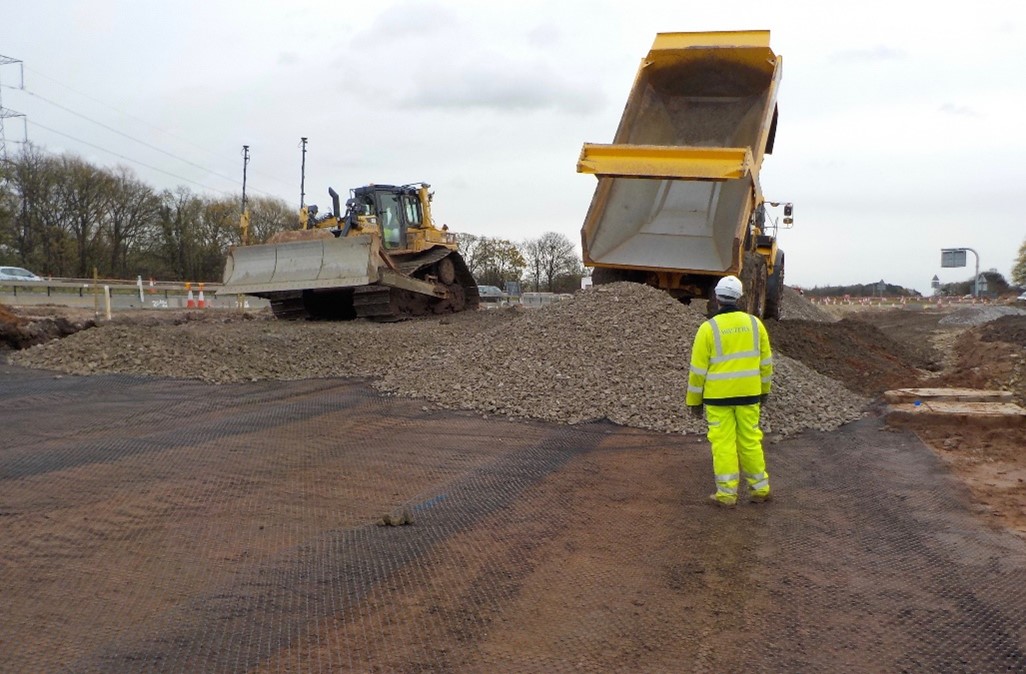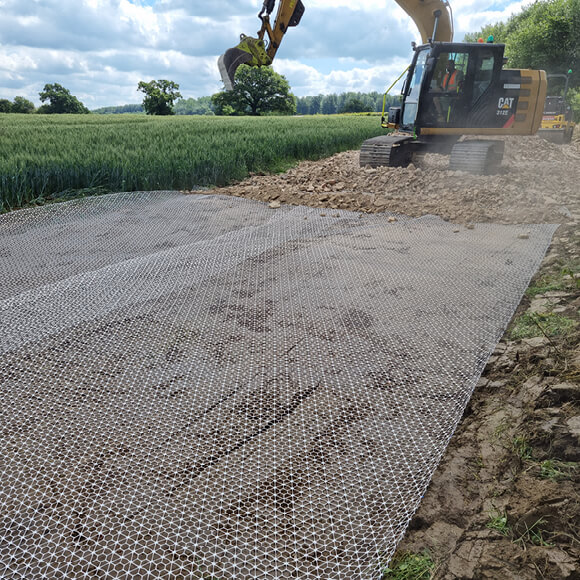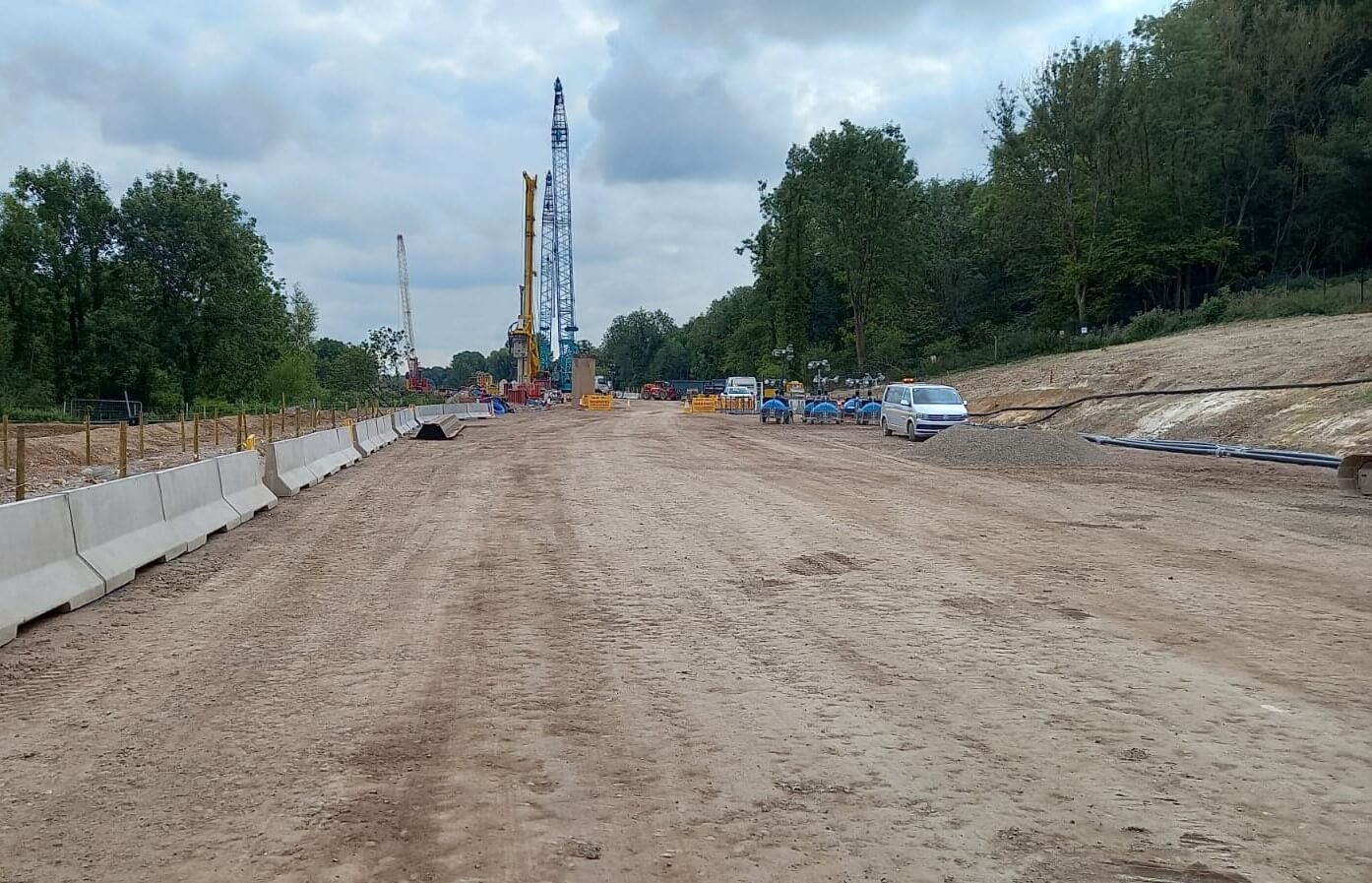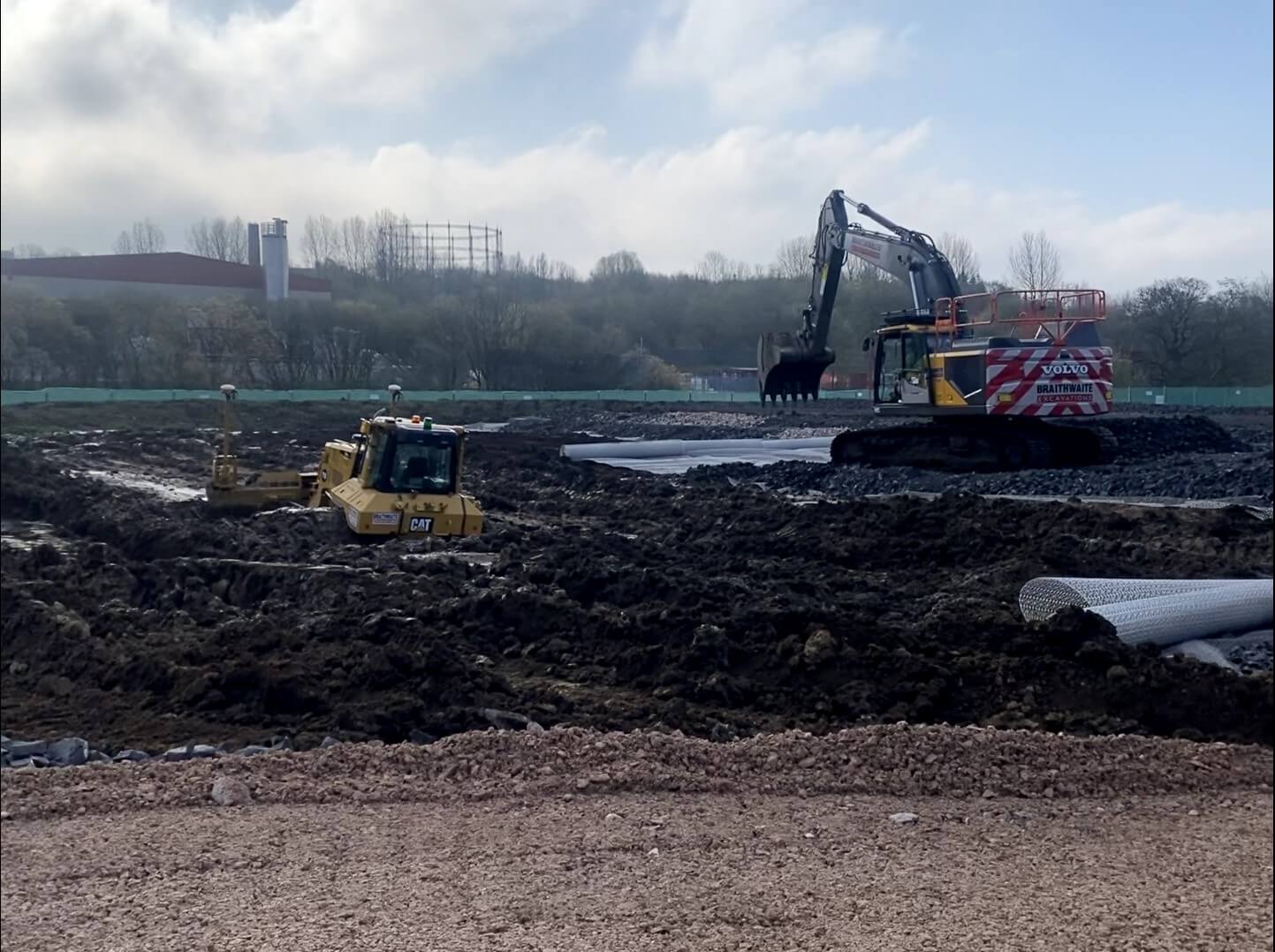Unpaved Roads: Definition, Design & Maintenance
Date: May 22, 2025
Unpaved roads are an essential part of construction projects, providing temporary or permanent access without the costs associated with paving. The UK has almost all of its road network paved – here, unpaved roads are most commonly constructed for temporary access. Typical uses are access roads for construction sites, farms, and rural properties, as well as haul roads for transporting materials such as timber and aggregates. In many other countries, permanent unpaved roads form part of the road network.
Designing unpaved roads requires careful planning. If you expect heavy traffic loads from machinery and vehicles, you’ll need to build an unpaved structure with enough bearing capacity to provide support. You’ll also want to factor in the condition of the soil, and how this could be impacted by changes in local weather throughout the life of the unpaved road.
Read on for a closer look at these unpaved road design considerations and other key areas like the materials you choose for construction. We’ll also explore the role of mechanically stabilised layers in improving the performance of unpaved roads. Towards the end of the guide, we unpack some of the challenges you might face when designing an unpaved road – and practical steps you can take to solve them.
Looking for something in particular? Use the links below to navigate straight to it:
Looking to design an unpaved road?
Reduce costs and ensure optimal performance with our free software, Tensar+.
Learn more
What are unpaved roads?
Unpaved roads are roads without a paved or bound surface. They are usually made up of natural materials such as gravel, soil, sand, or crushed stone. They are not as durable and stable as paved roads, and usually have a rougher, more uneven road surface.
You’ll find unpaved roads in rural areas where the construction of paved roads would be costly or impractical. In the UK, they’re commonly used for haul roads. An unpaved road may also be required to provide access to construction sites or large onshore wind farms, which are often located some distance away from permanent road networks.
Even with temporary unpaved roads, some maintenance may be required – such as grading to keep the surface as smooth and as functional as possible. This is especially the case if the road will undergo heavy loading from machinery and construction traffic throughout its design life..jpg) An unpaved road providing access to Glenchamber Wind Farm in Scotland.
An unpaved road providing access to Glenchamber Wind Farm in Scotland.
Unpaved vs paved roads
Unpaved roads typically require more frequent maintenance and upkeep than paved roads as they’re more susceptible to the weather and degradation from traffic. The lack of a protective surface means that high traffic loads will cause deterioration much faster than you’d expect with a paved road. Paved roads offer reduced maintenance frequency, but cost more and have a higher embodied carbon footprint due to the materials used in their surfacing, such as asphalt or concrete.
When evaluating whether to use an unpaved or paved road, you’ll first want to consider the intended use. Busy, high-traffic areas need a road surface for durability. On the other hand, an unpaved road may be suitable if you’re not expecting much vehicle traffic (for example, if you need a permanent driveway connecting a remote residential property to a main road).
If you’re looking to provide temporary access, such as to a construction site, you’ll typically opt for an unpaved road. In cases like this, creating a paved road surface would usually be considered unnecessarily expensive.
In some cases, a roadway may be designed and constructed to perform as an unsurfaced road during the construction period and then be paved in a second phase for long-term durability. This is common in roads for residential developments. It delays the expenditure on expensive paving and avoids construction related damage and discolouration to the paved surfacing.
For temporary access roads over weaker soils that need to be durable, or those subject to significant loading, we can combine an unpaved road with a suitable road stabilisation solution. In scenarios where you need to ensure that the road lasts for its design life without the need for costly and disruptive maintenance work, solutions like mechanically stabilised layers (MSLs) can help.
There are similarities between unpaved and paved roads. In both cases a stable road foundation is needed. We can use mechanical stabilisation to improve bearing capacity and reduce surface deformation and rutting. Design engineers can also use locally sourced materials and recycled aggregates for both paved and unpaved roads. This offers a more sustainable, cost-effective alternative to transporting primary materials to site.
Unsure whether a paved or unpaved road would work best for your next project?
Speak with our team for a free design consultation.

Which materials are used for unpaved roads?
Unpaved roads are usually constructed using a mixture of materials. In the UK, for example, we’ll often combine different types of aggregates together – such as a coarse graded crushed stone base layer topped with fine graded gravel. Where possible, access roads are constructed using locally sourced materials to make them adaptable to the needs of the area, saving both time and money from transportation and materials. Read on to discover the main types of materials used for unpaved roads.
Soil roads
Soil roads are made from local sand, silt, or clay, making them low cost and quick to create. This road type may be used for low-traffic areas, farm access and possibly for construction access for remote or undeveloped areas.
An unpaved dirt road's performance depends on the composition of the soil. In wet conditions, clay soils can become muddy and weak, making the road more difficult and perhaps impossible to use. Sandy soils, on the other hand, are particularly susceptible to erosion over time. Before deciding whether the local material is suitable for constructing a soil road, it’s essential to carry out a thorough site investigation to understand the underlying ground conditions. This process should include a soil test in construction, which evaluates key properties such as moisture content, compaction, grain size distribution, and bearing capacity.
Particle size distribution also affects the durability of unpaved soil roads. Fine soils are weaker and more sensitive to water content, whereas those with larger particles have greater strength as a result of increased inter-particle friction. The most durable unpaved soil roads have a wide particle size distribution range with no significant size gaps: in such cases, smaller soil particles fill the voids between larger particles, compacting to form a dense, stable layer.
Gravel and crushed stone roads
Suitable for heavy plant and construction traffic, gravel and crushed stone roads are a common choice for access roads on construction sites. This aggregate is usually sourced from quarries or borrow pits and used for both temporary and permanent unsurfaced roads. Sand can be used as part of the road base of unpaved roads, especially in areas with poor soil conditions – while providing a stable road base it also had good drainage properties. .jpg) An unpaved gravel access road at Riverview Estate
An unpaved gravel access road at Riverview Estate
Recycled aggregates
Recycled aggregates are a sustainable and cost-effective choice of material for unpaved roads. Derived from crushed and processed materials from previous construction projects, these aggregates offer a more sustainable approach than using primary aggregates for temporary access roads, reducing embodied carbon and costs. Due to their durability, recycled aggregates can be used for temporary and permanent roads.
The performance of recycled aggregates can be improved by stabilisation with Tensar geogrid. For the Blockley STW temporary haul road, Tensar used a mechanically stabilised layer (MSL) incorporating Tensar InterAx geogrids to stabilise the Series 600 6F2 recycled aggregates. This resulted in achieving the client's desired performance criteria in terms of construction and traffic.
Design considerations for unpaved roads
When creating an unpaved road design, it’s important to consider the cost and long-term performance. Understanding ground conditions, traffic loads and the local climate conditions is essential for creating a temporary access road that is fit for purpose for its intended lifespan.
Choosing the right materials.
Choosing materials for unpaved road designs takes careful consideration, especially as it can impact the road’s performance. Traffic volume and loading can play a huge factor in the design decisions – will the road have low, moderate, or high traffic? The chosen materials should also be well suited to the local climate conditions, such as rainfall and freeze thaw cycles.
You’ll want to consider the availability of local materials in your design plans. Using locally sourced materials saves on costs and transportation time – speeding up the construction schedule. Recycled aggregates, such as crushed brick or concrete, or secondary aggregates , such as mine waste or slag, could be used to reduce the need for primary materials while being more cost-effective and sustainable.
Tensar can reduce the material used in unpaved roads using Tensar InterAx® or TriAx geogrids. Our geogrids stabilise the aggregate layer to increase bearing capacity and reduce deformation while supporting traffic and maintaining design life, even in harsh climates. Our Tensar+ design software can calculate the layer thickness required for your project while reducing the amount of materials needed.
 The A556 project in Cheshire used Tensar’s TriAx geogrid to mechanically stabilise founding aggregate layers, saving an estimated £2m on the A556 improvement scheme.
The A556 project in Cheshire used Tensar’s TriAx geogrid to mechanically stabilise founding aggregate layers, saving an estimated £2m on the A556 improvement scheme.
Subgrade strength
Accounting for ground conditions is essential in the design phase to ensure the subgrade can support heavy traffic loads. If the construction takes place on a weak subgrade, it could lead to failures further down the line, such as excessive surface deformation. Protecting the subgrade can help to improve the load distribution while extending the road’s lifespan. Using Tensar’s subgrade stabilisation method, a mechanically stabilised layer incorporating Tensar geogrids, protects the subgrade structure during and after construction and increases bearing capacity.
In Gloucestershire, a temporary haul road for the Blockley STW used Tensar’s stabilisation solution for construction over a low-strength subgrade. After completion of the project, the road construction material was removed, and the land was handed back to the farmer. This solution achieved a 32% reduction in construction cost and 1.1 days in construction time.
 Tensar's design incorporating Tensar InterAx geogrid delivered a 34% cost saving for this temporary haul road
Tensar's design incorporating Tensar InterAx geogrid delivered a 34% cost saving for this temporary haul road
Load bearing capacity
Understanding the bearing capacity of an unpaved road is crucial. This determines the ability of the road to support the loads applied to it. The function of the road construction layers is to distribute load over a wider area to avoid exceeding the bearing capacity of the subgrade below, that would otherwise result in large deformations.
Another factor to consider is how tyre contact area in unpaved road designs can affect the bearing capacity. Materials used to surface unpaved roads typically have a lower bearing capacity than the tyre inflation pressure of trucks. When tyre pressure exceeds the aggregate's yield stress, the road surface will deform under the load – causing the tyre to ‘sink in.’ To prevent surface rutting, the bearing capacity of the aggregate needs to exceed the tyre contact pressure. This requires higher grade aggregates. For lesser quality aggregates, some surface deformation is inevitable.
The bearing capacity of unpaved roads can be increased by stabilising the road’s base layers, Tensar InterAx geogrid can be used to improve the strength and stiffness of the road layers and reduce deformation. The durability and life of the road is improved, saving you time and money. Our free engineering software Tensar+ can help you calculate the required road thickness to ensure your next project has the maximum stability.
Proper drainage
One key requirement when designing unpaved roads is to consider drainage options that will maintain a stable infrastructure. Without proper drainage, rainfall can saturate the road layers and subgrade, reducing strength and performance. This can be affected by soil types, surface drainage and ground water flow conditions. Poor drainage can also contribute to surface erosion and instability of the unpaved roads over time. Features such as ditches, cross slopes, and culverts are essential to prevent water from reaching the road surfaces.
Minimising maintenance
To avoid costly disruptions and future delays, you’ll want to keep maintenance requirements to a minimum. Frequent maintenance, such as re-grading, can be time consuming, slow down operations, and add extra cost. Poor surface quality of unsurfaced access roads can slow the movement of plant and equipment, delaying construction project timelines. To maintain the integrity of unsurfaced roads for a longer duration, Tensar geogrids can be incorporated into your unpaved road design, stabilising the roads and creating reliable access with very minimal upkeep – meaning construction work or materials haulage can remain within budget and to schedule.
Constructing mechanically stabilised layers for temporary unpaved roads.
Mechanically stabilised layers (MSL) for unpaved roads can ensure stability and enhance performance. The subgrade needs to be prepared, ensuring it is trimmed to the required grade. Tensar stabilisation geogrids can be laid directly over the subgrade, followed by the selected aggregate placed and compacted on top. The geogrid interlocks with and confines the aggregate, creating a mechanically stabilised layer (MSL) that can control particle movement both vertically and laterally. Bearing capacity is increased as the load is distributed more widely – reducing stress on the subgrade. Up to a 50% reduction in thickness can be achieved while maintaining the design service life of the unpaved road.
Construction of the Colne Valley Viaduct, part of the HS2 rail project, required temporary site roads and working platforms to be built close to existing lakes, on soil with shallow groundwater levels. Excavation depth needed to be limited to avoid disturbance of the sensitive subgrade soils and to prevent construction delays. Tensar proposed a mechanically stabilised layer (MSL) design to support construction traffic loads, such as concrete mixers, and delivery vehicles.
Mechanical stabilisation of the granular layer avoided the use of chemical soil treatment, saving £700,000 in cost. A reduction of 25,000 m3 of imported aggregate, and 2,000 lorry movements were taken off the local roads. Overall, the use of a mechanical stabilised layer (MSL) created a longer lasting design at lower cost and with reduced impact to local roads and the environment.
A Tensar geogrid stabilised unpaved access road leading up to a working platform on the HS2 Colne Valley Viaduct project
Challenges associated with unpaved roads.
While unpaved roads are regularly used for temporary and permanent access roads, they can come with their own set of challenges. Read on to explore the key challenges of unpaved roads – and how you may overcome them.
Surface degradation
Heavy traffic and inadequate subgrade support can quickly degrade unpaved roads, Rutting occurs in the wheel paths, leading to reduced bearing capacity, water ponding, speed reduction and poor ride quality.
Tensar’s ground and subgrade stabilisation can strengthen the unpaved road and improve its overall load-bearing capacity. Over weak and variable soils, a subgrade improvement layer will protect the subgrade during construction creating more durable roads that perform better over time – even with high traffic loads. By minimising surface degradation and subgrade rutting, unpaved roads become more reliable and durable in the long term.
Weather vulnerability
Weather conditions, such as sustained rainfall, flooding, drought, or periodic freezing can have a huge impact on the life of unpaved roads.
Long periods of rainfall can lead to saturation and softening of the subgrade causing failure of the road and large deformations. High rainfall intensity and flooding can erode the road surface, forming gullies and causing poor ride quality. Sustained drought periods can dry out the road causing dust problems during trafficking and loss of material in high winds.
Perioding freezing can have high impact. When water enters the road layers and freezes, it expands and exerts pressure. This repeated freeze-thaw weathering, can weaken aggregates, reduce compaction, and cause further degradation over time. Tensar geogrids can provide stabilisation while reducing the road’s exposure to some of the weather-related damage. By creating a mechanically stabilised layer, geogrids can maintain the structural integrity.
Adverse weather can also have a major impact on the construction of unpaved roads. Saturation of subgrade soils following periods of sustained rainfall can make them far weaker than may have been assumed during the design stage. Saturated subgrade soil makes placement and compaction of the aggregate layers difficult. Deep rutting and remoulding of weak clay subgrade soil during construction reduces the soil strength further, building-in problems for the future. The use of Tensar stabilisation geogrid directly over the weak subgrade improves accessibility and reduces subgrade deformation. As the aggregate layer is placed, it interlocks with the geogrid and the particles are confined, improving compaction and increasing the bearing capacity of the road layer.
A real-world example of how use of a Tensar geogrid can enable road construction to take place even after severe weather events comes from this project in Nelson, Lancashire. Construction of roads for the Lomeshaye Industrial Estate required ground stabilisation. As part of the enabling works, the original design specified lime stabilisation, but following a period of high rainfall, this method of stabilisation was abandoned by the contractor as the construction plant was causing major disturbance and further weakening of the clay subgrade. Tensar provided an alternative design with a mechanically stabilised layer incorporating Tensar InterAx geogrid to protect the subgrade and provide a strong stable road foundation.  Tensar InterAx geogrid was placed directly over the subgrade, weakened by high rainfall and construciton traffic movement, to protect the subgrade and enable construciton to proceed.
Tensar InterAx geogrid was placed directly over the subgrade, weakened by high rainfall and construciton traffic movement, to protect the subgrade and enable construciton to proceed.
Maintenance costs
Maintenance is required to keep unpaved roads safe and passable – but it can add an extra and often unexpected cost. Frequent resurfacing and damage repair can become a financial burden over time, especially to construction projects with tight budgets or limited resources. How frequently maintenance is required is unpredictable and it will depend on factors such as environmental conditions and usage. Without regular upkeep, temporary access roads can become dangerous and could create hazards for construction vehicles and site workers. Poorly maintained roads could also lead to project delays and affect the wear on construction vehicles or haulage trucks.
Impact of traffic load
High traffic loads and regular use by heavy vehicles can significantly contribute to the deterioration of unpaved roads. Heavy trafficking of unpaved surfaces can cause displacement and loss of surfacing material leading to thinning of the road layer and subsequent loss of strength. A greater issue is rutting and permanent deformation of the subgrade that can result from large loads and high traffic volume. The deformation causes remoulding and weakening of the subgrade. Rutting at the subgrade surface also leads to increase saturation of the subgrade as water is held in the ruts, further softening the subgrade. Tensar geogrids strengthen and stiffen the aggregate layers, distribution traffic loads over a greater area, reducing subgrade stress and consequent rutting. Incorporating geogrids into your next projects can improve long-term performance in high-traffic conditions.
Unpaved roads case study: Bertha Cut
In this project in Perth, Scotland, a section of new road needed to be constructed between the A35 and Bertha Cut. This would serve as an unpaved access road during construction and then be paved for permanent access to the development. The road passed through a cutting with highly saturated soils and groundwater lying above road level. Construction of a capping layer to form the road foundation was attempted, but was unsuccessful due to the extremely soft soil, weakened by weather and construction vehicles.
With Tensar’s help, a mechanically stabilised layer design was developed that incorporated a single layer of Tensar geocomposite to stabilise the capping layer. The geocomposite combines a Tensar stabilisation geogrid with a non-woven geotextile to improve separation. This design was integrated with a new drainage system to overcome the challenging ground and groundwater conditions. The soil stabilisation solution was successful, allowing construction of a stable capping layer with the required 10% CBR value to serve as a foundation for the permanent road.
 Construction of the Tensar mechanically stabilised layer taking place on the Bertha Cut project
Construction of the Tensar mechanically stabilised layer taking place on the Bertha Cut project
How Tensar can support the construction of unpaved roads
This guide has introduced you to unpaved roads, which materials are best suited for this road type, and design considerations to help reduce regular maintenance. We’ve also explored how you can overcome some of the common challenges associated with unpaved roads.
Our free geotechnical Tensar+ software can help you with the design process of unpaved roads and solutions for any challenging surfaces, while providing insights into how we can support your next project. Using our Tensar geogrids, we can improve the effectiveness of unpaved roads, ensuring it can support heavy traffic loads and withstand challenging weather conditions.
Have an upcoming project using temporary access roads?
We’ll produce a complimentary “Application Suggestion” to show how we can help you cut costs and material usage in your unpaved road design.




.jpg?width=400&height=400&ext=.jpg)